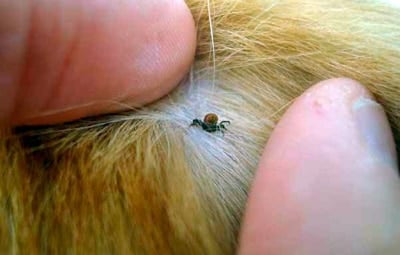All of us who are fortunate enough to have a dog in our lives know what it’s like to be worried about your pet getting fleas or ticks. Ticks are very common on ticks, which is why you need to know how to detect them, get rid of them, and most of all, how to prevent them.
In this simple, practical guide, you’ll learn everything you need to know about ticks, including what to do and how to get rid of them effectively. Remember that the best way to not have ticks is to prevent them, which is actually very simple and will only take a little bit of your time each week.

What are ticks?
Ticks are a large type of mite (up to half a centimeter) that live as parasites on the skin of mammals, feeding on their blood according to Wikipedia. They have four pairs of legs that end in claws, which they use to grip tightly to their hosts. This makes it much easier for them to make a tiny puncture through which they suck their food, the host’s blood.
They are most common in warm locations, or when spring/summer causes temperatures to rise. They usually abound near farms or trails where livestock pass through. Ticks can transmit a number of diseases, many of which are serious. It is completely necessary to remove any and all ticks from your dog or pet, because they can also latch onto humans.
Adult females can lay up to 4000 eggs during their life cycle, meaning you can soon find yourself with a huge infestation if you don’t take action.
Ticks on adult dogs and puppies: How to detect them
Detecting ticks on your dog is very simple. All you have to do is check them carefully every now and then keeping an eye out for these unwanted visitors. As a general rule, ticks tend to “anchor” themselves near the ears, or even inside them, near the face and the neck. They may also attach on your dog’s back, belly, or even his paws, but this is less common.
It’s very important to take your time and thoroughly inspect your dog, from the tip of his nose to the tip of his tail. That way, you’ll know if your dog has any ticks on his body. Generally, you’ll see a small brown or black bump, like a big, ugly zit. If you find a tick, don’t try to remove it! There is a simple process you need to follow so that your dog doesn’t suffer.
Ticks are more common in puppies because they are usually too young to receive the pipettes or collars that prevent them. But don’t worry, it’s very easy to get rid of ticks on puppies, so no need to panic.
Ticks can vary in size from two or three millimeters up to a centimeter or centimeter and a half, depending on how long they’ve been feeding on the host, your beloved pet.

How do you get rid of ticks?
Following these instructions correctly is very important, because ticks attach themselves to your dog with their legs and also make a small puncture with their mouth. You must kill or repel the tick before removing it from your dog; otherwise, its legs could get stuck in his skin, causing an unnecessary infection.
There’s no rush, don’t worry. You’ll get rid of ticks properly from this day forward using a very simple technique: making it detach from your dog and then removing it (dead or alive).
Ticks don’t like citrus or chamomile tea, meaning you can use either of these liquids (chamomile or lemon juice) to make the tick detach from your dog. Apply a bit of cool chamomile tea or lemon juice (apple cider vinegar also works) on top of the tick and wait a minute for it to detach: Home remedies for fleas and ticks

Using tweezers, carefully extract the tick, making sure its legs or head don’t stay stuck in your dog’s skin. Then, kill it in a scrap of paper or by dunking it in a plastic cup of alcohol. Once that’s done, apply some peroxide to the bite on your dog to disinfect it. Over the next few days, apply peroxide to the bite so that it doesn’t get infected. If you see signs of infection (pus, excessive inflammation, bad smell), go to your veterinarian to get an antibiotic.
How to prevent ticks on adult dogs and puppies
Prevention is the best action you can take against ticks. It negates the inconvenience of having to find them and eliminate them, something that generally isn’t a pleasant task. All it takes is applying one of these fantastic pipettes to your dog once a month, which are sold in veterinary clinics, pet stores and online pet pharmacies. These pipettes contain a chemical compound that makes ticks feel very uncomfortable on your dog, so they won’t go anywhere near him.

Pipettes will vary according to the size of your dog; dogs weighing 45 lbs or less need a smaller dose of this chemical product than larger dogs do. Larger dogs, weighing more than 45 lbs, usually need two pipettes: one applied to the base of the neck and the other at the base of the tail. Dogs weighing 45 lbs or less only need one pipette at the base of the neck.
Pipettes should be applied once per month, preferable two days after giving them a bath. A clean dog who is bathed each both with soap and water has less risk of getting fleas, ticks and diseases than a dirty dog.

Collars are another effective method to prevent your dog from getting ticks. They work in the same way as the pipettes, releasing a smell that repels ticks and fleas, making them not want to feed on your dog.
It’s slightly more complicated for puppies; because they are so small, collars and pipettes are completely contraindicated for them, since the chemical compounds they contain can be harmful to them. However, there are collars made with natural compounds, like neem oil, which is a natural repellant. You can use these natural collars on you puppy with no problem, thus keeping them from getting infested.
Pipettes should be applied once a month, while collars have an average duration of two to four months.
Can humans catch ticks from dogs?
The answer is YES. Besides, it’s very dangerous to have ticks because they carry many diseases, some of which are very serious. It’s important to keep your dog clean and with the right collars or pipettes so that they don’t get ticks and pass them on to us. Now, it’s not all bad; ticks always prefer to live on mammals with a lot of hair, making dogs preferable to humans. But that doesn’t mean there is no risk, just that the risk is lower.
If you find a tick on you, you should see your doctor to get the proper medicine to prevent illness (typically antibiotics).
Summary:
The best way to not have ticks is to prevent them. A monthly bath for your dog is recommended. A day or two after his bath, apply an anti-flea and tick pipette. Give your dog a flea and tick repellant collar. This will give you complete prevention against ticks, simple and practical.





